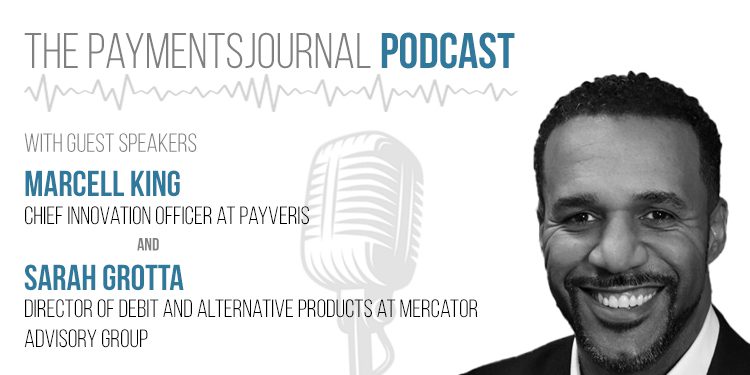It’s 2022 and many consumers are splitting restaurant bills with peer-to-peer (P2P) apps and initiating a wide range of payments without having ever written a check, or in some cases, even having a checkbook.
On the flip side, according to Payveris Chief Innovation Officer Marcell King, some consumers are making big-ticket monthly payments for items such as cars and mortgages by dispatching a paper check with a paper coupon through the mail to move those loan payments to their lenders. The latter situation is a combination of legacy systems that haven’t been reimagined and a gaping need for banks and other lenders to anticipate what their customers’ payment preferences are and will be.
King and Sarah Grotta, Director of Debit and Alternative Products at Mercator Advisory Group, joined an episode of the PaymentsJournal podcast to discuss the issues around faster payments in the loan industry, what the opportunities are for banks and credit unions, and the risks involved in not evolving to meet the needs of modern consumers.
King cited his own children — all in their 20s and at an age to be taking on car loans, mortgages, and other monthly payments — as evidence of what these lenders are up against with today’s borrowers. None of his children, he said, owns a checkbook.
“For a consumer to have to pay their loan with a check and a coupon, it’s kind of ludicrous,” he said. “From a loan payments perspective, you have to be able to give the consumer the ability to pay with whatever method they want that’s eligible for a loan repayment.”
Where Customers Are, and Where Lenders Must Go
Grotta said the prescription must be a consumer-first, consumer-centric approach. “If a financial institution thinks about that first, [it’s] always going to have a more successful solution,” she said. “But I don’t think the banking industry has necessarily done that to date.”
Grotta and King both discussed what she calls “the decentralization” of the financial lives of consumers, who might have some money in a mobile wallet, some in a checking account, and some in a PayPal or Venmo account. Consumers will want to draw on those pockets of money and might find themselves stymied when it’s time to repay their loans.
“You don’t want to constrain your customers,” King said.
It’s not just a matter of meeting customers where they want to be. A bank or credit union that might have only a lending relationship with a given consumer and proceeds to limit the interactions with that borrower misses on a chance to expand the relationship.
“It really diminishes your cross-sell opportunities,” Grotta said.
The Burden of Legacy Systems
Lenders that haven’t been able to rise to the occasion of greater payment flexibility and speed are primarily burdened by two factors, King and Grotta said:
- Legacy systems. “Ten- or fifteen-year-old, sometimes twenty-year-old, systems” that were built for the payment methods that flourished at the time they were instituted, King said.
- An aversion to risk.
Taking an “if it’s not broken, why fix it?” approach is a risk, King said, because any lender waiting to hear what a consumer wants in terms of payment flexibility isn’t likely to receive that feedback.
“Customers generally aren’t going to ask for something,” he said. “They’re just going to find what’s most convenient for them. You miss a little bit of the boat there.”
He suggested that banks, credit unions, and other lenders view the matter through these customer-centric lenses and leverage the data they’ve gathered:
- Who are your customers or borrowers?
- What are the payment tools they’re using?
Grotta cited Mercator studies on consumers’ preferred channels and payment types and the “stark difference” between how payments are made today and how consumers would prefer to make the payments.
The U.S. bill pay market — not just loans, but all forms of bill pay — is $4 trillion, Grotta said. “It’s worth paying attention to.”
The Stakes, by the Numbers
With fintechs, neobanks, and others crowding into the lending marketplace, customers’ satisfaction will only expand as a point of differentiation. Here’s the ringing bell for financial institutions: Consumers like these new players.
A 2021 J.D. Power and Associates study of satisfaction with mortgage servicers uncovered startling statistics:
- Non-bank servicers are driving satisfaction. Overall satisfaction with loan servicers increased by six points, but most of that was fueled by a 17-point increase in satisfaction with non-bank servicers.
- Larger banking relationships matter. Satisfaction scores among customers who also use their mortgage servicer’s bank products are 55 points higher than the scores of those who have only a mortgage with that servicer.
- The online channel/self-service options at financial institutions need help. Only 38% of customers say they found the information they sought within the first two pages of a servicer’s site. When customers had to go to through more than two pages, their overall satisfaction plummeted by 55 points.
King noted that nontraditional lenders, such as Rocket Mortgage, many of which are tech companies first, are “leveraging technology to provide consumer convenience, speed, and simplicity — things that the consumers are looking for — to differentiate their products from other products and other organizations.”
Grotta said banks, credit unions, and other traditional lenders have unmet opportunities in making payments both frictionless for consumers and in leveraging tools associated with those faster, less cumbersome payment methods. Texted prompts and alerts about things such as late payments and overdrafts create high-response touchpoints with consumers and build trust.
Ryan Cole, the podcast host, quoted Mercator Advisory Group’s Vice President of Payments Innovation Tim Sloane, who called payments “an ‘and’ industry,” in that it’s ever-expanding in its offerings, in its methods, and in what consumers want from it.
Striving to meet consumers is worth the effort, King said. “Loans are a primary source of revenue for financial institutions,” he said. “If you don’t make it easy for consumers to make their payments, it’s going to lead to frustration.”










